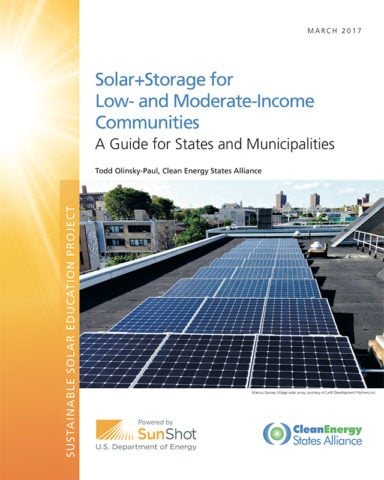Bringing the Benefits of Solar+Storage to Low-Income Communities: A Guide for States and Municipalities
In recent years, some states and environmental NGOs have begun to focus on low-income community access to clean energy technologies such as solar PV. Low-income households account for about 20 percent of the nation’s residential energy use, and the energy cost burden weighs more heavily on these households than on others. But until recently, the low- and moderate-income (LMI) market was largely overlooked. Several barriers, including low rates of home ownership and a perception of higher investment risk, have meant that these communities are the last to benefit from new energy technologies.
The new focus on finding ways to put solar into LMI communities is a good one. But Clean Energy Group and the Clean Energy States Alliance (CESA) are looking ahead to make sure that these communities also have access to the combination of solar PV with energy storage technologies (solar+storage). The reasons are simple: while solar alone is good, the combination of solar+storage can provide more benefits, and the addition of storage may help to safeguard against the devaluation of solar, for example due to declining net metering rates or the imposition of time-of-use pricing. In the case of multifamily housing and commercial properties, the addition of energy storage may even provide a faster payback than solar alone, because it can be used to manage demand charges. Resilient power, defined as the ability to self-supply with electricity when the grid is down, is another key benefit provided by the addition of storage.
 Because LMI communities are most in need of the many benefits solar+storage can provide, it is important that this combined technology become accessible to them sooner rather than later. To help state and municipal energy agencies support the development of solar+storage in LMI communities, CESA has published a new report, Solar+Storage for Low- and Moderate-Income Communities: A Guide for States and Municipalities. While several previous reports have explained the economic and power resiliency benefits of solar+storage, this new report focuses on the tools states and municipalities can use to support solar+storage in LMI communities. It is one of six program guides CESA is producing as part of its Sustainable Solar Education Project, which is supported by the U.S. Department of Energy SunShot Initiative.
Because LMI communities are most in need of the many benefits solar+storage can provide, it is important that this combined technology become accessible to them sooner rather than later. To help state and municipal energy agencies support the development of solar+storage in LMI communities, CESA has published a new report, Solar+Storage for Low- and Moderate-Income Communities: A Guide for States and Municipalities. While several previous reports have explained the economic and power resiliency benefits of solar+storage, this new report focuses on the tools states and municipalities can use to support solar+storage in LMI communities. It is one of six program guides CESA is producing as part of its Sustainable Solar Education Project, which is supported by the U.S. Department of Energy SunShot Initiative.
Many of the tools outlined in the report will be familiar to state and municipal agencies, which are accustomed to employing grant and rebate programs, utility procurement targets, financing programs and tax incentives to support clean energy measures. However, energy storage, and the combination of battery storage with solar, is a relatively new technology, with new applications. Providing LMI communities access to these technologies will require more innovative use of the policy, program and finance tools in the public policy toolkit.
One of the guide’s conclusions is that because establishing new state or municipal programs to support new technologies can be challenging – especially when budgets and staff bandwidth are stretched by many competing interests – it may be faster and more effective to add electric energy storage (batteries) as an eligible technology under existing programs that support solar PV. Solar incentives, energy efficiency programs, and renewable or alternative energy portfolio standards already exist in many states; these programs are a natural fit for energy storage, because storage can work in tandem with solar and other technologies already supported by these programs.
For example, the proposed Massachusetts SMART solar incentive would include a new adder for solar installations that include energy storage; the larger the storage component relative to the solar component, the larger the storage adder the project would receive. The SMART program also offers adders for projects in low-income communities for rooftop solar, for community solar, and for brownfield redevelopment – all of which can help to target deployment toward LMI customers. And these adders are stackable, meaning that a single project can qualify for numerous adders.
Energy efficiency programs represent another important opportunity to leverage existing programs in support of solar+storage in LMI communities. Often, energy efficiency program budgets dwarf other incentive and grant programs supporting renewables and storage. For example, Massachusetts budgeted over $680 million for energy efficiency in 2014. In order to allow energy storage developers access to this resource, the 2016 State of Charge report, which analyzed opportunities for storage deployment in Massachusetts, recommended that energy storage be included as an eligible technology in future energy efficiency plans.
It’s important to note that adding energy storage into existing clean energy incentive programs may sometimes require changes in the way program goals are defined. For example, including storage as an efficiency measure may require energy efficiency program administrators to adopt a new, more expansive definition of efficiency. Rather than simply defining efficiency as using less energy, a broader definition of efficiency could include reducing the customer’s cost of electricity; expanding the use or value of distributed renewably-generated electricity; and shifting electricity purchases to off-peak times, which can lower costs for the consumer as well as lowering costs and emissions for the regional grid. Such adjustments may also require states and municipalities to produce analysis showing how storage can enhance and expand the value of solar in meeting program objectives.
Another take-away from the guide is the importance of supportive financing. This was demonstrated in solar PV’s progression from a niche technology to a mainstream, commercial product. In addition to sharp decreases in manufacturing costs, the rise of third-party solar leasing contributed to the dramatic increase in deployment of rooftop solar in the U.S. It is now possible, in some places, to acquire a rooftop solar system at no initial cost, and to start realizing energy cost savings in the first month.
However, these solar financing opportunities have largely been limited to affluent customers with high credit ratings, who own their own properties. It has been much more difficult for LMI households and businesses to access solar financing.
If states and municipalities wish to provide the benefits of solar+storage to LMI communities at scale, and move markets beyond demonstration projects supported by government grants, it will be important to support new financing mechanisms that can overcome the barriers that have traditionally prevented clean energy investment in these communities. In general, this means using public resources to provide financing directly or to lower risk for other financiers. States and municipalities have many innovative financing options that can be employed, including various type of bond finance, clean energy financial institutions such as green banks, public-private ownership structures, and credit enhancements.
A third lesson from the guide is the important role of utilities in public clean energy policies and programs. Utilities are necessary partners due to interconnection requirements, but they also bring important resources to the table. In addition to their ability to develop projects directly in LMI communities, utilities can also help to create markets through net metering, demand response programs, and contractual partnerships with customer- and third-party-owned solar+storage systems. If such partnerships are properly structured, the utility can benefit from grid services that energy storage can provide from behind the meter, such as reduced demand during peak periods, which can lower utility cost obligations for capacity and transmission services. This is a model that is being pioneered by Green Mountain Power in Vermont
There are numerous ways for states to leverage utility resources to support solar+storage in LMI communities. One direct method is to establish a utility procurement mandate, as was done in California and Oregon, and is currently being discussed in Massachusetts. Such a mandate can include carve-outs for behind-the-meter systems, and incentives for LMI systems. Utilities can also support the market for customer-sited solar+storage through energy efficiency and demand response programs. Municipal utilities in particular can often allocate resources to support municipal goals, such as providing resilience and energy assurance to LMI communities, while simultaneously using solar+storage resources to reduce ratepayer costs. A good example is the Sterling Municipal Light Department project in Massachusetts.
As can be seen from the above, providing the benefits of solar+storage to LMI communities can be challenging, and success may require a multi-pronged approach. States and municipalities would do well to adopt a comprehensive suite of programs. Grants, rebates and incentive programs, utility procurement, financing support, open markets regulations, technical assistance and soft cost reductions are all important tools to expand the market for solar+storage technologies to all consumers.
For a more thorough discussion of these and other policy tools, download the guide. You may also view the CESA webinar on this report in CESA’s webinar archive.
***
This article was also published in Renewable Energy World.
Published On
March 31, 2017

